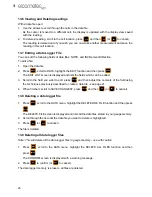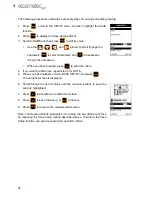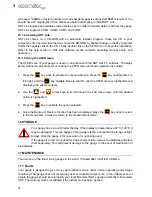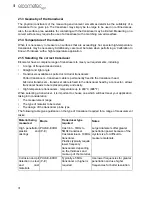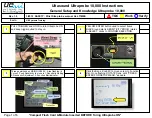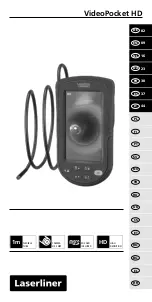
34
en
temperatures above 100°C (~200°F), the change in sound-velocity of the material being measured
starts to have a noticeable effect upon the accuracy of ultrasonic measurement.
At such elevated temperatures, it is recommended that the user perform a calibration procedure on
a sample piece of known thickness, which is at, or near, the temperature of the material to be
measured. This will allow the gauge to correctly calculate the velocity of sound through the hot
material.
When performing measurements on hot surfaces, it may also be necessary to use a
high-temperature transducer. It is recommended that the transducer be left in contact with the
surface for as short a time as needed to acquire a stable measurement. While the transducer is in
contact with a hot surface, it will begin to heat up, and through thermal expansion and other effects,
may adversely affect the accuracy of measurements.
23.4 Measuring laminated materials
The density (and therefore sound-velocity) of laminated materials may vary considerably from one
piece to another. Some laminated materials may even exhibit noticeable changes in sound-velocity
across a single surface. The only way to reliably measure such materials is by performing a
calibration procedure on a sample piece of known thickness. Ideally, this sample material should
be a part of the same piece being measured, or at least from the same lamination batch. By
calibrating to each test piece individually, the effects of variation of sound-velocity will be minimised.
An additional consideration when measuring laminates, is that any air gaps or pockets within the
laminate will reflect the ultrasound beam. This will be noticed as a sudden decrease in thickness in
an otherwise regular surface. While this may impede accurate measurement of total material
thickness, it does provide positive indication of air gaps in the laminate.
23.5 Measuring through paint and coatings
When measuring through paints and coatings the sound-velocity of the paint/coating may be
significantly different from the sound-velocity of the actual material being measured. An example of
this would be a mild steel pipe with approximately 0.6 mm (.025") of coating on the surface. The
sound-velocity of the pipe is 5918 m/s (.2330 in/µsec), and the sound-velocity of the paint is
2286 m/s (.0900 in/µsec). If the gauge is calibrated for mild steel pipe and measures through both
materials, the actual coating thickness will appear to be 2.5 times thicker than it actually is, as a
result of the differences in sound-velocity.
The error can be eliminated by using the echo-echo mode to perform measurements for
applications such as these. In echo-echo mode, the paint/coating thickness will be eliminated
entirely and the steel will be the only material measured.




